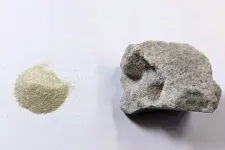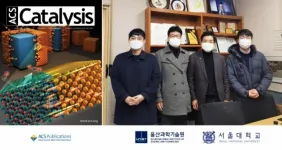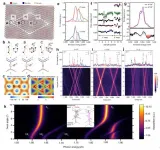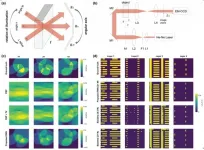(Press-News.org) When people are asked to draw the flower of a sunflower plant, almost everyone draws a large circle encircled by yellow petals.
"Actually, that structure is the flower head, or the capitulum, which may be composed of hundreds of flowers, also known as florets. The surrounding 'petals' are florets different in structure and function to those closer to the centre," says Professor of Horticulture Paula Elomaa from the Faculty of Agriculture and Forestry, University of Helsinki, Finland.
A giant inflorescence is beneficial, as it is effective in attracting pollinators. When pollinators move around the inflorescence, they pollinate hundreds of individual florets over the course of their journey.
The order of the florets in a flower head is not random. Instead, they are patterned into regular spirals whose number follows the Fibonacci sequence familiar from mathematics. Fibonacci numbers are the sum of the two preceding numbers in the sequence: 1, 1, 2, 3, 5, 8, 13, 21, 34, 55, 89, 144...
In the flower head, the number of left- and right-winding spirals is always two consecutive Fibonacci numbers. Sunflower flower heads can have as many as 89 right-winding and 144-left winding spirals, while the gerbera, another much-studied plant from the Asteraceae plant family, has fewer spirals (34/55).
The geometric regularity of nature has fascinated both biologists and mathematicians for centuries.
"The gerbera is a favourable study subject, because we can use transgenic plants grown in a greenhouse as tools when investigating the functions of individual genes, for example, during the development of the plant. In the case of sunflowers, gene transfer is not yet a routine procedure. The gerbera genome, which is close to the size of the human genome, is currently being sequenced. Experience has shown that the gerbera is an excellent model plant," says Elomaa, who has contributed to Finnish gerbera research ever since its infancy in the late 1980s.
Now, for the first time, the researchers have been able to examine on the molecular level how floral primordia are patterned into spirals in the growing point, or the meristem, of gerberas. They have had available to them a technical solution whose utilisation in plant science could only be dreamed of a couple of decades ago.
With the help of X-ray tomography, the researchers scanned three-dimensional images of the different stages of meristem development. Using confocal microscopy, they surveyed meristems as small as under one millimetre in size to determine where the plant hormone auxin, which determines the position of the primordia, is located.
Finally, the researchers applied mathematical modelling to the data gained in cooperation with Professor Przemys?aw Prusinkiewicz from the University of Calgary. The end result was a three-dimensional computer model that emulates the patterning of a real flower head.
The researchers found that the meristem of the gerbera is patterned on the molecular level already at a stage where no primordia or other changes are discernible by even an electron microscope.
"During growth, auxin levels rise to the maximum simultaneously in several locations of the meristem. The number of these clustered spots, which are called auxin maxima, increases rapidly as the diameter of the meristem grows, following the Fibonacci numbers. A new auxin maximum is always formed between two neighbouring maxima and moves so that it is always closer to the older of the neighbours. This is why the spirals are regular even in meristems that are not entirely symmetric."
The findings demonstrate that the expansion growth of the meristem is the factor that affects, for example, the eventual number of florets in the flower head.
"Among other things, this effect is seen in seed yield, an important factor for the sunflower, as it is specifically cultivated as feed and food. It is also possible that the same model explains the number and patterning of floral organs. In the future, this information will be applied to, for instance, the strawberry. In strawberry the size of the fruit is regulated by the number of pistils," Elomaa notes.
INFORMATION:
Tokyo, Japan - Researchers at the Institute of Industrial Science, a part of The University of Tokyo, have developed a new method of producing concrete without cement. They have directly bonded sand particles via a simple reaction in alcohol with a catalyst. This may help both to slash carbon emissions and to construct buildings and structures in desert regions, even on the Moon or Mars.
Concrete consists of two parts: the aggregate (typically made of sand and gravel) and cement (responsible for 8% of total global CO2 emissions). Despite there being a huge amount of sand in the world, the availability of sand for concrete production is fairly limited because sand particles must have a specific size distribution ...
A recent study has unveiled the reason behind the exceptional catalytic performance of non-noble metal-base mixed catalysts. This is thanks to a new synthetic strategy for the production of cube-shaped catalysts that could further simplify the structure of complex catalysts.
This breakthrough has been led by Professor Kwangjin An and his research team in the School of Energy and Chemical Engineering at UNIST, in collaboration with Professor Taeghwan Hyeon and his research team from Seoul National University. In their study, the researchers found a new principle that active charge transfer, which appears at the interface created between the two types of non-noble ...
TMDs vdW heterostructures generally possess a type-II band alignment which facilitates the formation of interlayer excitons between the constituent monolayers. Manipulation of the interlayer excitons in TMDs vdW heterostructures hold great promise for developing excitonic integrated circuits that serve as the counterpart of electronic integrated circuits, which allows the photons and excitons transforming between each other and thus bridges the optical communication and signal processing at the integrated circuit. Consequently, numerous researches have been carried out in order to get a deep insight ...
A wide range of objects, from biological cells to integrated circuits, are tomographically imaged to identify their interior structures. Volumetric reconstruction of the objects' interiors is of practical implications, for instance, quantitative phase imaging of the cells and failure analysis of the circuits to validate their designs. Limiting the tomographic angular range is often desirable to reduce the time of radiation exposure and avoid any devastating effects upon the samples, or even unavoidable due to the structure of objects like in the case of tomosynthesis for mammography. However, tomographic reconstruction from limited angular views is not always welcome in an algorithmic sense, ...
Research by Australian scientists could pave the way to a new treatment for a currently incurable brain cancer in children called Diffuse Intrinsic Pontine Glioma, or DIPG. Affecting about 20 children in Australia each year, DIPG is a devastating disease with an average survival time of just nine months after diagnosis.
The research, led by scientists at Children's Cancer Institute and published this week in the international journal, Cell Reports, offers an exciting new therapeutic approach for the treatment of DIPG by using a new anti-cancer drug.
The new drug, CBL0137, is an anti-cancer compound developed from the antimalarial drug quinacrine. The researchers found that CBL0137 directly ...
Intestinal worm infections can leave women in sub-Saharan Africa more vulnerable to sexually-transmitted viral infections, a new study reveals.
The rate and severity of sexually-transmitted viral infections (STI) in the region are very high, as are those of worm infections, which when caught in the intestine can change immunity in other parts of the body.
Researchers at the Universities of Birmingham and Cape Town led an international team which discovered that intestinal worm infection can change vaginal immunity and increase the likelihood of Herpes simplex virus type 2 (HSV-2) infection - the main cause of genital herpes. ...
Non-alcoholic fatty liver, NAFLD, is associated with several health risks. According to a new registry study led by researchers at Karolinska Institutet in Sweden, NAFLD is linked to a 17-fold increased risk of liver cancer. The findings, published in Hepatology, underscore the need for improved follow-up of NAFLD patients with the goal of reducing the risk of cancer.
"In this study with detailed liver histology data, we were able to quantify the increased risk of cancer associated with NAFLD, particularly hepatocellular carcinoma," says first author, Tracey G. Simon, researcher at the Department of Medical Epidemiology and Biostatistics, Karolinska Institutet, and hepatologist at Massachusetts General Hospital and Harvard ...
An outbreak of vomiting among dogs has been traced back to a type of animal coronavirus by researchers.
Vets across the country began reporting cases of acute onset prolific vomiting in 2019/20.
The Small Animal Veterinary Surveillance Network (SAVSNet) at the University of Liverpool asked vets for help in collecting data, with 1,258 case questionnaires from vets and owners plus 95 clinical samples from 71 animals.
Based on this data, a team from the universities of Liverpool, Lancaster, Manchester and Bristol identified the outbreak as most likely to ...
ITHACA, N.Y. - Women's increased agricultural labor during harvest season, in addition to domestic house care, often comes at the cost of their health, according to new research from the Tata-Cornell Institute for Agriculture and Nutrition (TCI).
Programs aimed at improving nutritional outcomes in rural India should account for the tradeoffs that women experience when their agricultural work increases, according to the study, "Seasonal time trade-offs and nutrition outcomes for women in agriculture: Evidence from rural India," which published in the journal Food Policy on March ...
PHILADELPHIA-- Humans have a uniquely high density of sweat glands embedded in their skin--10 times the density of chimpanzees and macaques. Now, researchers at Penn Medicine have discovered how this distinctive, hyper-cooling trait evolved in the human genome. In a study published today in the Proceedings of the National Academy of Sciences of the USA, researchers showed that the higher density of sweat glands in humans is due, to a great extent, to accumulated changes in a regulatory region of DNA--called an enhancer region--that drives the expression of a sweat gland-building gene, explaining why humans are the sweatiest ...





